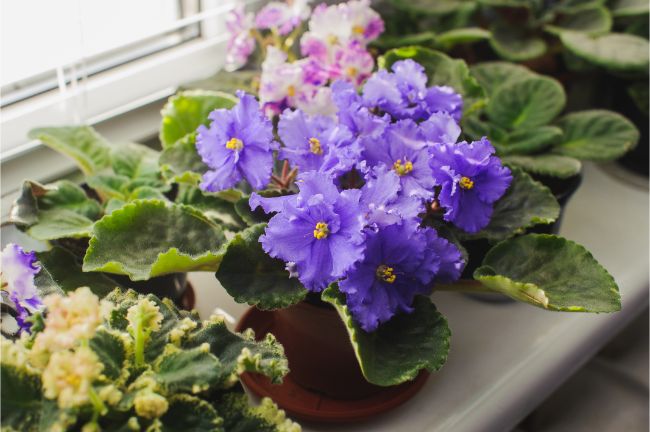African violets (Saintpaulia ionantha) are one of the world’s most popular flowering houseplants, so we expect them to … you know, flower. Experts insist they easily bear an endless springtime of blooms, to which many of their owners sadly shake their heads. Both sides are right: African violets do bloom easily year-round, but they’re also a little weird.
How to get African violets to bloom. African violets need bright indirect light, humidity, consistent fertilization and watering, but never overwatering. They also need frequent repotting in shallow and smaller pots than normal.
This article is about helping you get that know-how, so we’ll go through the basic requirements and also a few special tips. The only thing we can’t help you with is falling in love with them—all we can say is that you won’t be alone.
African Violets 101
This special plant has been a favorite for generations for good reason. They thrive in our preferred home temperatures. As “day-neutral” plants, they don’t care about daylight length and can flower year-round. They live for decades and are commonly passed down as heirlooms.
Discovered in 1892, African violets quickly became international favorites. Named for their original color rather than for being true violets, and they were quickly hybridized into thousands of varieties.
They are classed in unofficial leaf-diameter sizes. In recent years, the trend has been to keeping smaller specimens which take up little space.
• Giant: over 16 inches
• Standard/Large: 8 to 16 inches
• Mini/Semi-mini: 4-6 to 6-8 inches
• Super-mini: 3 to 4 inches
• Micro: under 3 inches
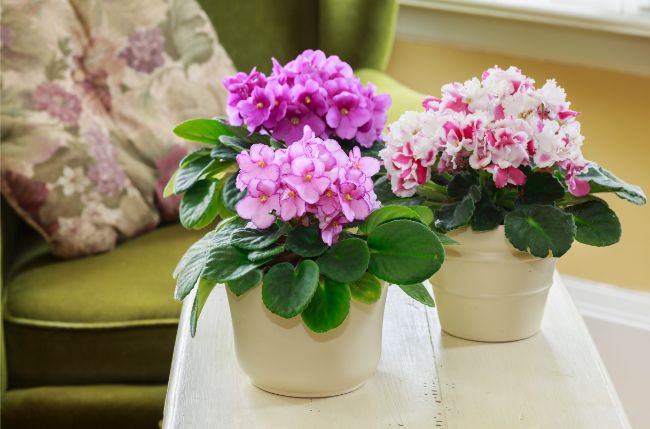
African Violets Need Bright Light To Bloom Consistently
Inadequate light is the most common reason African violets don’t bloom—luckily, it’s not hard to get right. African violets are perfect windowsill plants.
They need moderate to bright indirect light to perform well. An eastern exposure works well for most the year, but northern and western light is fine if they don’t get too warm. A southern exposure is best in winter months.
African violets also do well under fluorescent lighting. Plain tubes are fine; no need for a fancy setup.
The plant can survive in weaker light, but you won’t enjoy many flowers and may even start seeing yellow leaves. They can stand some direct rays in the morning or late afternoon, but hot direct sun scorches their leaves and causes brown spots.
One simple way to determine proper lighting is to hold your hand over a violet when it’s getting its brightest light. You should be able to see a faint shadow.
Beauty sleep is important to African violets, so give them at least eight hours of darkness each night. Their flowering hormones won’t activate until it’s been dark for an adequate period.
Correct Watering Is Essential To Get African Violets To Bloom
Watering is another important factor in blooming, and a big reason why African violets have the reputation for being fussy. If you just water the little darlings along with the rest of your green babies, instead of bounteous flowers you’ll probably just get mushy dead plants.
They need moist soil that isn’t wet around their roots, so let the soil dry out slightly before rewatering. This is where it goes wrong for most newcomers: few plants enjoy wet feet, but African violets toss in the towel immediately. They can’t stand a drought, either.
PRO TIP: Note how much their pot weighs after watering. This helps you gauge when it’s time to re-water.
Let’s say it again: Never let the soil become soggy or dry. You’re halfway to African violet profusion already.
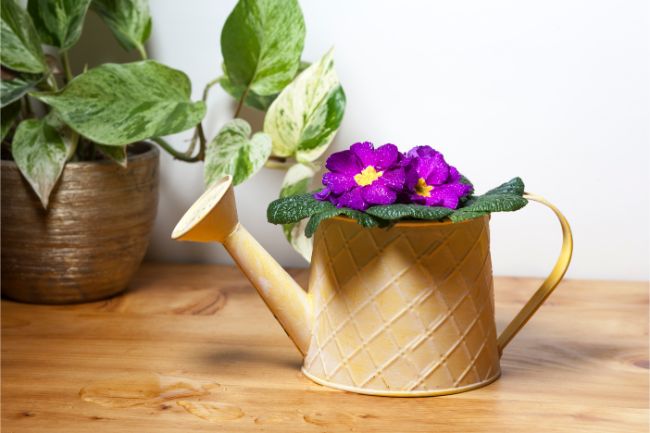
Water Your African Violets With Quality
• Don’t use softened water. It adds salt and causes unneeded root suffering. If you have a softener, find another source—maybe your outside taps aren’t affected. Distilled water or rainwater is fine, or ask a neighbor who doesn’t use a softener. You don’t need much.
• Only use room-temperature water that’s been aged or dechlorinated with aquarium drops. The process of removing root-burning chlorine from water is called conditioning, which sounds more complex than it is … just leave it out overnight.
• You can water from the top if you’re careful to avoid the leaves, which spot easily. Normally leaf spotting only happens with cold water, but I always take care to avoid getting the leaves wet when watering anyway. Bottom watering is easier if the pot is filled with foliage. To do this, put the pot in a bowl with an inch of conditioned water and let it absorb it for 30 minutes before lifting it out and draining.
Self-Watering Pots
Because most mortals can’t hover over their plants, there are special self-watering pots to keep the soil evenly moist but not sodden. There are ceramic and plastic options for self-watering pots, which work in slightly different ways.
Ceramic pots have double walls, with a glazed outer pot to hold water and an inner unglazed pot the water soaks through. To start the self-watering process, it helps to soak the inner wall with hot water before placing the soil inside. Water from the top to make the soil evenly moist. Once primed, the filled outer reservoir should handle things from there.
Plastic pots usually have a water reservoir in the base and wicks that slowly deliver water by capillary action from the reservoir, into the soil. I’ve written an article about some of my favorite self-watering pots that I’ve used with great success.
Sometimes self-watering pots can be a little temperamental, so keep an eye on the soil. Takeaway: You have to remain observant no matter the watering method.
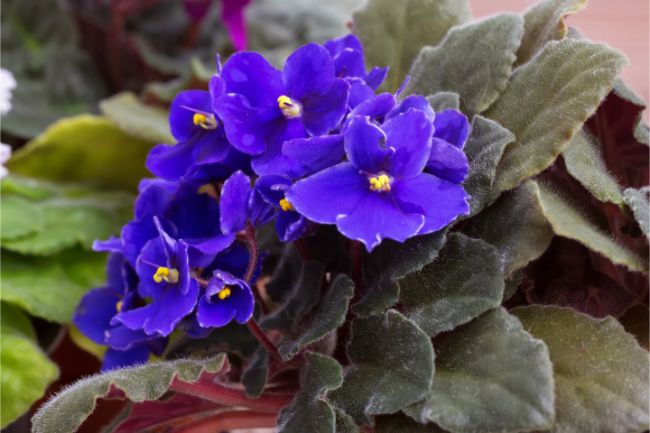
Temperatures To Promote African Violet Blooms
This one is easy, because African violets like the temperatures we do. Their optimal comfort range is from 65°F to 75°F. 70°F is considered perfect, but they can bloom freely from the low 60’s to high 70’s.
Rapid and/or extreme fluctuations are to be avoided, so don’t leave them on the windowsill on cold nights … and remember to put them back once it warms up in the morning!
Lengthy periods at higher temps cause legginess, loss of blooms, and a change in water requirements. Really cold temperatures kill, of course, but even excessive coolness will quickly stop flowering. Be careful about setting African violets on a porch or other unprotected area.
Raise The Humidity!
Another reason you might not see blooms on your violet is low humidity. These African natives like about 50%. Actually, they like more than that, but they’ll bloom if you meet them halfway.
Our arid homes struggle to get above 10-20% humidity, especially in the heated, dry winter months. You’ll have to make adjustments.
The simplest thing is to group your plants, making sure their leaves aren’t touching. It’s also helpful to use water-filled trays that evaporate moisture into the air around them. Putting pebbles in the tray or saucer lets you place the pots right over the water without wetting their roots.
PRO TIP: Clay pots are another humidity helper. These absorb water and gradually release it to increase local humidity.
These steps are usually enough—if not, you can invest in a humidifier to completely solve the issue. Be aware their regular filling and maintenance does involve more effort. I’ve written an article covering 10 of the best ways to easily increase humidity for your plants.
Air Quality Can Impact Blooming
One invisible element that can affect African violet blooms is air quality and circulation. The humidity they prefer is a rich medium for pathogens, so make sure each plant has good airflow around it, and isn’t touching others.
The second issue with air quality is the presence of chemical fumes like gas, paint, and household cleaners. Ventilate their growing area whenever fumes are suspected. Signs of air pollution include pale, stunted leaves or brown buds and flowers.
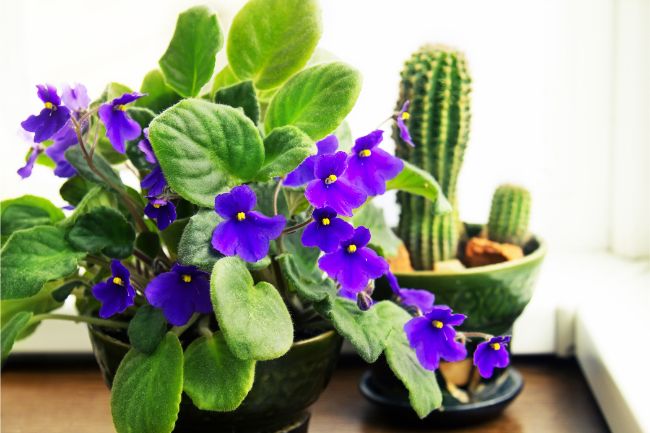
Light, Fluffy Soil
African violets need porous potting soil that drains easily but retains moisture. Sphagnum peat moss or light mixtures of perlite and similar materials are good for keeping the soil open and light.
The soil should have a pH of between 5.8 and 6.2, which is very slightly acidic. Peat is too acidic unless buffered with lime or another amendment. This sounds more complicated than it usually is in practice: many commercial potting soils match these requirements.
PRO TIP: You don’t really need special African violet soil; many are too heavy, anyway.
The small size of African violets makes them susceptible to pathogens in their soil. A reputable retail brand poses little threat; but, if you have doubts, you can pasteurize it by spreading the soil on a baking sheet and heating it to 180 degrees for 30 minutes.
In any case, store your potting soil in an airtight container or bag to prevent contamination.
Choice Of Pot Is Important To Keep African Violets Blooming
This is one of those African violet quirks we mentioned. You certainly need to make sure the pot has adequate drainage … but that’s not the quirky part.
In the wild, these plants live in rock crevices. They like tight quarters. The rule is to pot them in a container 1/3 the diameter of their leaf span—considerably smaller than most plants prefer.
For example, a 9-inch wide plant needs a 3-inch pot. If you give them a larger pot, African violets tend to get lost and languish without producing many flowers. This is a common mistake, so don’t make it!
African violets also like shallow pots, often called Azalea pots. Deep pots can leave wet and poorly aerated soil beneath their shallow roots and cause health problems.
Fertilization Tips
We could make this complex, but we’ll skip the chemistry lesson. A balanced fertilizer works well. You don’t want high nitrogen content, though—you’ll end up with lovely green foliage but fewer blooms.
Also, avoid urea-containing fertilizer, which can burn their roots. The Guaranteed Analysis portion of the label normally lists urea if it’s present.
An easy shortcut is to buy a reputable African violet food. Do check the N-P-K numbers to be sure it provides a balanced mix.
You can go with organic fertilizers, but manure-based products tend to be nitrogen heavy. Earthworm castings and “worm tea” are best.
There are two common ways to fertilize:
• Every two weeks to a month. Apply less often if your plant gets less light in winter.
• Fertilize with watering. Dissolve ¼ to ½ teaspoon of soluble plant food in a gallon of water.
Quick-release fertilizers are generally best. It’s best to know how much your violet is getting—and when. Use fully-dissolving mixes that don’t leave sediment. This is the preparation I use and I’ve had consistently excellent results.
Repotting Matters For African Violet Blooming
Repotting—or rather, not repotting—is another reason newcomers have problems with blooming. The soil in their small pots needs regular refreshment. Also, African violets like being slightly rootbound … but not too much.
Most experts recommend repotting twice a year. Unless the plant has grown larger, they are repotted into the same container size.
Necking
African violet leaves normally spread low, just above the soil; however, their lower leaves fade over time and are best removed. The process causes the plant to develop a bare, stem-like “neck.” This happens more slowly in plants getting correct light, but it’s inevitable.
A special procedure called necking removes this stem:
1) Repot when the soil is moist so it holds together. Remove older lower leaves.
2) Carefully lift the plant out of the pot. Handle by cupping the root ball or holding the neck to avoid dirtying or damaging the leaves.
3) Cut away the bottom of inch of soil and roots with sterilized cutters. When removing a neck, cut off the same measurement of bottom soil as the length of the bare stem.
4) Put moist soil back in the pot and create a hole the size of the remaining root ball.
5) Reset the plant in the pot. The leaves should come just above the pot’s rim.
6) Fill around the neck with fresh potting soil. New roots will grow along the buried stem.
PRO TIP: Tweezers are useful when handling small plants; the back of a spoon helps tamp under leaves.
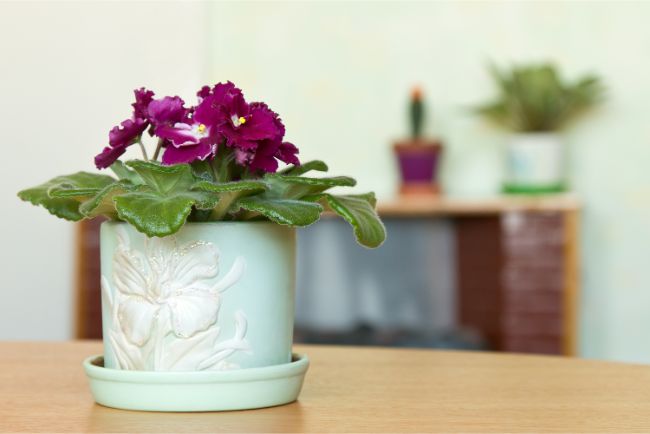
Special Blooming Techniques
We’ve covered the basics, but here are some tricks to keep your African violets happy and blooming:
- Leaf Cleaning – Although many people worry about leaf spotting, you can actually rinse or immerse the leaves of your African violet in water to clean them as long as you use room temperature water. Cold water causes localized leaf necrosis, but your plant won’t mind water that is at a similar temperature to the rest of the plant. Ideally use distilled water or rainwater too. I normally rinse my plants in a sink of room temperature water every 6-12 months.
- Soil Drenches – This trick washes out salts and fertilizer the plant didn’t use. Do this when the soil already needs watering. Pour room-temperature, conditioned water into the pot’s soil until excess water comes out the drains. Tip the pot to make sure all the water is out. Resume normal watering, but don’t fertilize for a week. Do this every three months.
- Rotation – Symmetry is part of the African violet’s beauty. Rotate their pots weekly so that the light reaches all sides. Regular rotation produces a balanced bloom pattern, too.
- Leaf Support – The lower leaves can become marred by resting against a pot with thin edges. Leaf supports help them grow symmetrically and may increase their light exposure. Support rings are commercially available, or can be made inexpensively from plastic pie plates.
- Cutting out the Middlemen – You want to keep your African violet’s energy directed to the job of making flowers. Trailing species aside, they only need 3 or 4 rows of leaves to bloom, so keep them trim and focused.
- Old Growth – Spent blossoms go to seed. Regularly pinch off old flowers and their stems to conserve energy for new growth.
- Disbudding – This helps your violet grow quickly for increased future flowering by temporarily directing energy to new leaves and roots. Remove buds and their stems with a sharp, sterilized knife. Complete disbudding will boost the plant’s growth the most, but it’s not necessary.
- Crowns – African violets form new plantlets through crowns. This drains the parent plant of nutrients, so they should be removed. The good news is they can become new plants. Start with relatively dry soil. Remove the whole plant from its pot and gently pull the crowns apart. If the roots are intertwined, you can cut them—but keep roots on each section if possible.
- Suckers – Cut them off! They waste energy and don’t bloom anyway.
Crowns and even rootless sprigs will grow into a new plant. Just plant in potting soil. You can help them sprout by giving them a plastic cover: a grocery store lettuce container works well.
Blooms Ahead!
I hope this article has been helpful in helping you get your African violet to bloom. African violets can behave a bit strangely—it’s one of their charms. Learn what makes them happy and they’ll colorfully return the favor.

